- India
- International
Finger-lickin’ good: The story of chutney in India
In most meals, the chutney is on the margins of the plate as an accompaniment. But, in its variety of ingredients and burst of flavours, it remains the common taste that binds our multicultural eating practices together.
 Sweet and Spicy: Mint coriander chutney, popular in north India (Photo: Getty Images/Thinkstock)
Sweet and Spicy: Mint coriander chutney, popular in north India (Photo: Getty Images/Thinkstock)
To tell the story of chutney in India, it may, perhaps, be best to begin with the origin story of the chaat. It’s fairly well-known — and, arguably, apocryphal — but it illustrates the many qualities that the chutney, in its various forms, brings to a meal. It is said that once, when the Mughal emperor Shah Jahan fell ill, his hakims recommended that he eat a dish which was spicy and flavourful, yet easy to digest. Thus was invented the chaat — built on a foundation of lentils and pulses, but finished with a dribble of spicy mint and coriander chutney and sweet-sour date and tamarind chutney. The last two ingredients — the chutneys — were what gave chaat its name, since both are said to have originated from the Sanskrit word chaatni — which means “to lick”.
What this says about the use of chutneys is worth noting. In most meals, the chutney is, of course, only an accompaniment. It is always on the margins of the plate. All you need is a little dab to enliven a drab meal. “A tiny amount of chutney is supposed to last an entire meal. It is made in a way that you’re supposed to lick it, not masticate it,” says food historian Pushpesh Pant. “It is served in small quantities to supplement other items (in the meal). Like pickle, it contributes ‘rasa’, or basic taste, that may be missing otherwise. However, while pickle is a processed, preserved food, most chutneys are prepared fresh,” he says. In its freshness and rawness, thus, the chutney delivers a small, but powerful dose of micronutrients that may, otherwise, be missing from the meal. In its use of certain ingredients like pudina (mint), jeera (cumin), saunth (dry ginger), chutney is also believed to be an aid to digestion, as Shah Jahan’s hakims had recommended. Above all, however, the chutney — no matter which part of the country it is from — is a flavour bomb, lifting any meal above the mundane.
In its simplest form, the chutney is merely a paste comprising various ingredients, crushed on a grinding stone or pounded in a mortar with a pestle. Is it possible, then, that the chutney is the oldest form of prepared food known to humans? Pant believes so. “It is reasonable to suggest that the chutney is older than any other recipe known by homo sapiens. It was most likely ‘invented’ by our hunting-gathering ancestors by accident, maybe even before cooking transformed our eating habits. Crushed berries, fruit and leaves, seeds and nuts render whatever we put in our mouth tastier and slowly become a habit or preference,” he says.
But is the chutney just an accompaniment or — in the way that it is increasingly used — an Indian counterpart to modern condiments like ketchup and mustard sauce? Chutney, really, is a concept, made in kitchens across India, a few hours — or even minutes — before a meal is served. It is the idea that no meal should lack in interest and no food should go to waste. Actor and chef Tara Deshpande says, “In many parts of India, chutney is a way to use up leftover ingredients, to enjoy seasonal ones, and, to use cheap ingredients to prepare something with lots of flavour. Often, an ingredient that was very healthy, but not too tasty, like flax seeds (agasi or javas) was turned into a chutney so that it would be palatable.”
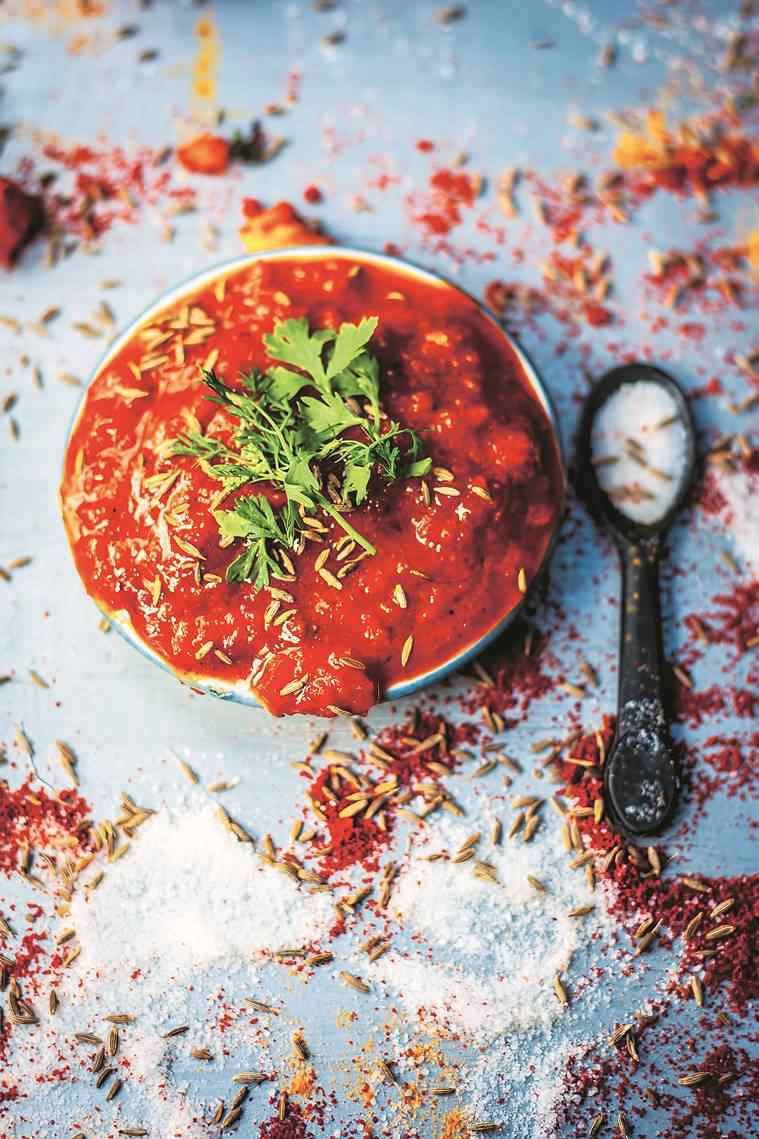 Tomato chutney; in its simplest form, the chutney is merely a paste comprising various ingredients, crushed on a grinding stone or pounded in a mortar with a pestle. (Photo: Getty Images/Thinkstock)
Tomato chutney; in its simplest form, the chutney is merely a paste comprising various ingredients, crushed on a grinding stone or pounded in a mortar with a pestle. (Photo: Getty Images/Thinkstock)
In Indian culinary history, chutney has performed another more essential function, too. “I believe that chutneys have a strong correlation with poverty. They rule the palate in arid zones or where the land is otherwise not as fertile,” says Pant. It also became the chief accompaniment for the main carbohydrate for those whose access to food and fuel was restricted for social and economic reasons. Deshpande says, “The poor often eat bhakri, onions and lasnachi chutney (garlic chutney) in Maharashtra. The spicy, salty condiments are a way to satiate hunger by overpowering the senses, so you feel like you ate a lot, but didn’t. (It’s) a sad thought.”

Preparing chutney requires little to no fuel as it’s usually uncooked. It can be made with just a few ingredients, whether they’re foraged or grown in the backyard. In some parts of the country, this means an abundance of ingredients that can be used, even if one didn’t have the means to buy or grow them oneself. So, in Uttarakhand, in whose hilly terrain hemp grows well, various parts of the plant have been a kitchen staple and one of the signature chutneys of the region is hemp seed (bhaang) chutney. Or, take the chaprah chutney, popular in Bastar, Chhattisgarh, that is made by crushing a certain kind of red ant — found aplenty there — with other ingredients. The ants, besides adding flavour to the meal, are also an excellent source of protein.
One could say that the choice of ingredients is circumscribed by the micro-climate of the region, but like with all creative endeavours — which is what cooking really is — the limits placed on cooks is an unfettering of sorts. It is this that has led to the creation of chutneys that speak eloquently about the conditions in the regions of their origin. A region’s traditional thali may give you a snapshot of the kind of food that the people there value, but it’s in the chutney — that basic food that frequently substitutes a side dish — that you’ll see what they have had to make do with.
A good example of this is Nagaland. “We must have chutney with every meal. Most of the time, chutney makes up for the absence of any side dishes. Many tribal families live a hard life and do not have the luxury of making side dishes. That’s how the chutney became an integral part of tribal cuisine,” says Karen Yepthomi, head chef and owner, Dzukou Tribal Kitchen, Delhi. Chutneys also provide heat and big, bold flavours to food that is otherwise very simply cooked. “Everything, from the rice to the protein — whether it’s pork or beef or fish or chicken — to the vegetables, is steamed or boiled. The chutney, which is usually made with ingredients like green chillies, raja mirchi, axone (fermented soybean paste), and fermented fish, adds the heat and spice. The amount of spices depends on how much heat you can tolerate,” says Yepthomi.
Or take the hot, arid interiors of Andhra Pradesh, home to chutneys made from an astonishing variety of ingredients, including tomato, gongura (roselle), ginger, green chillies, all varieties of gourds, cabbage, brinjal and even gram flour. “Even if the people didn’t have access to anything else, they could still eat their rice with chutneys,” says Y Narayan Reddy, food consultant at Tenali Hospitality in Delhi. “There’s a very good reason why it is said that in Andhra Pradesh, your meal begins and ends with chutney. It is that important a part of the cuisine. Some kind of chutney is eaten with every course of the meal, and, sometimes, the meal is just curd, rice and chutney,” he says.
Chutney has, over time, become an umbrella term for the various types of thecha (Maharashtra), chammanthi (Kerala), pacchadi (Andhra Pradesh), thogayal (Tamil Nadu) and other such forms of this food that have developed across the country. This includes the various kinds of podi (powder) found across south India, which are mixed with ghee or oil before being eaten. Pant suspects that the term “chutney” became the pan-Indian term for this category of food under the influence of the British who, he says, developed a taste for chutney because, being eminently adaptable to all types of palates, the chutney helped them cope with the strong flavours of Indian food.
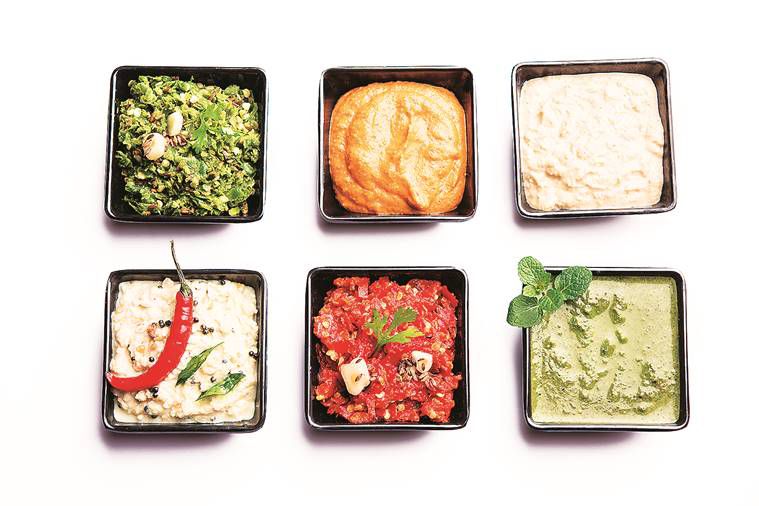 Variety is the spice: Wherever you go, the chutney is the ubiquitous accompaniment to Indian meals. (Photo: Getty Images/Thinkstock)
Variety is the spice: Wherever you go, the chutney is the ubiquitous accompaniment to Indian meals. (Photo: Getty Images/Thinkstock)
The British, in fact, considerably expanded the scope of the term “chutney”. In Hobson-Jobson, the “glossary of colloquial Anglo-Indian words and phrases, and of kindred terms etymological, historical, geographical and discursive,” as the subtitles states, chutney (spelled “chutny”) is described as “a kind of strong relish, made of a number of condiments and fruits, etc, used in India, and more especially by Mahommedans, and the merits of which are now well known in England.” Of course, like all things mediated by the British, when the concept of chutney left Indian shores, it turned into a different beast. Much like how kedgeree has little in common with khichdi, and mulligatawny is a far cry from rasam, the English chutney travelled quite a distance from its Indian inspiration. This is especially notable in the use of vinegar and the overemphasis on sweetness (derived from different fruits and sugar).
According to many accounts, the earliest form of this chutney is Major Grey’s chutney — originally a commercial name that soon became the name for a type of chutney — which is still available, and sold by different brands. According to The Routledge History of Food (2015), it is thought to have been developed by a British officer who had travelled in India. “The formula was eventually sold to Crosse and Blackwell, a major British food manufacturer, probably in the early 1800s,” notes the book. In a piece titled, ‘Tea and Chutney: 2 Different Greys’ in The New York Times (July 10, 1982), food critic Mimi Sheraton described Major Grey’s as a “mild chutney, as compared with the spicier blends such as Colonel Skinner and Hot Bengal Club”. She wrote, “Crosse & Blackwell, which claims the ‘genuine’ formula, is very sweet, soft and jamlike; it is made in this country with ingredients such as corn syrup, caramel colouring and dehydrated onions, which one doubts could have been part of the original recipe.”
Food historian and consultant Pritha Sen, however, argues that Major Grey’s was most likely inspired by Colonel Skinner’s Chutney. She says, “In the 18th century, a mercenary called Colonel James Skinner ran his own regiment known as Skinner’s Horse, which eventually became the 1st Bengal Lancers. He was a foodie, experimenting with various kinds of cooking, and he invented this chutney using ginger, garlic, mango — dried or, when in season, fresh — and Kashmiri red chilli. This chutney inspired many others, including Major Grey’s.” Sen also says that this chutney is a good illustration of how much the British and the Indian culinary traditions borrowed from each other during the colonial period. “The British borrowed the name ‘chutney’ from us, and we were inspired by their sweet jams and preserves to make the sweet chutneys that are part of Bengali meals today.” Given that Bengal was at the heart of the British colonial world — with Calcutta as its capital for the first 100 years — this culinary cross-influence is unsurprising.
Traditional Bengali chutney forms like baata and aumbole pre-dated the Raj, and served many purposes — to aid digestion, cool the body and use food parts that would otherwise go to waste. However, Sen argues, that many Bengali chutneys as we know them today — whether it’s the tomato chatni or the plastic chatni ( made of raw papayas) — were most likely developed during the colonial period. During this time, sweet and sour chutneys became popular with affluent sections of the society, who were enamoured of exotic new ingredients like tomatoes. Sen says, “The richer you were, the more ingredients, like dried fruits, you added to the recipe.” These chutneys were used as palate cleansers at the end of the meal and before the eating of desserts.
The chutney is an ubiquitous fact of Indian cuisine no matter where you go, and made from a mind-boggling variety of ingredients, from the hemp seed chutney of Uttarakhand to the tangy and spicy-peanut-and-green-chilli chutney from Rajkot in Gujarat to the Kashmir’s doon chetin, made of walnuts. To turn one chutney into a completely different kind of chutney, ingredients can be subtracted or added, and they can be roasted, fried or used plain. For example, peanuts are added to the standard mint-and-coriander chutney in Gujarat to achieve creaminess and a distinct nutty flavour. Then there is the familiar coconut which, when ground with some green chillies and a bit of ginger, and tempered with mustard seeds and curry leaves, becomes the mildly-sweet breakfast accompaniment that is the standard coconut chutney. That same coconut, however, when roasted and made into Kerala’s varutha thenga chammanthi, achieves a deeper, more complex flavour.
In a country as stunningly diverse as India, it’s hard to find a single unifying factor, especially when it comes to food. Rice may be one common thread that binds us all, as is dal. Chutney, perhaps, could also be counted as one, given how much we rely on it to sustain us and how much delight we take in transforming the most mundane of ingredients into a bright, piquant and delicious melange for our meals.
Doon Chetin (walnut chutney) — Kashmir
 Kashmir’s doon chetin, made of walnuts.
Kashmir’s doon chetin, made of walnuts.
Ingredients:
50g – Walnut kernels, washed and ground coarsely
1 tbsp – Onion
¼ cup – Green chillies
¼ tsp – Black cumin seeds (shah jeera)
¼ tsp – Dry mint leaves
Salt to taste
1 tsp – Green coriander, chopped
1 cup / 180g – Yogurt, hung in a muslin cloth for two hours
Method:
Mince the onion and green chillies together and mix all the ingredients together
Courtesy: Wazwaan: Traditional Kashmiri Cuisine by Waza Sharief, Shafi and Rafiq with Rocky Mohan (Published by Roli Books); Photo Courtesy: Dheeraj Paul/Roli Books
Dondakaya Chutney (ivy gourd chutney) — Andhra Pradesh
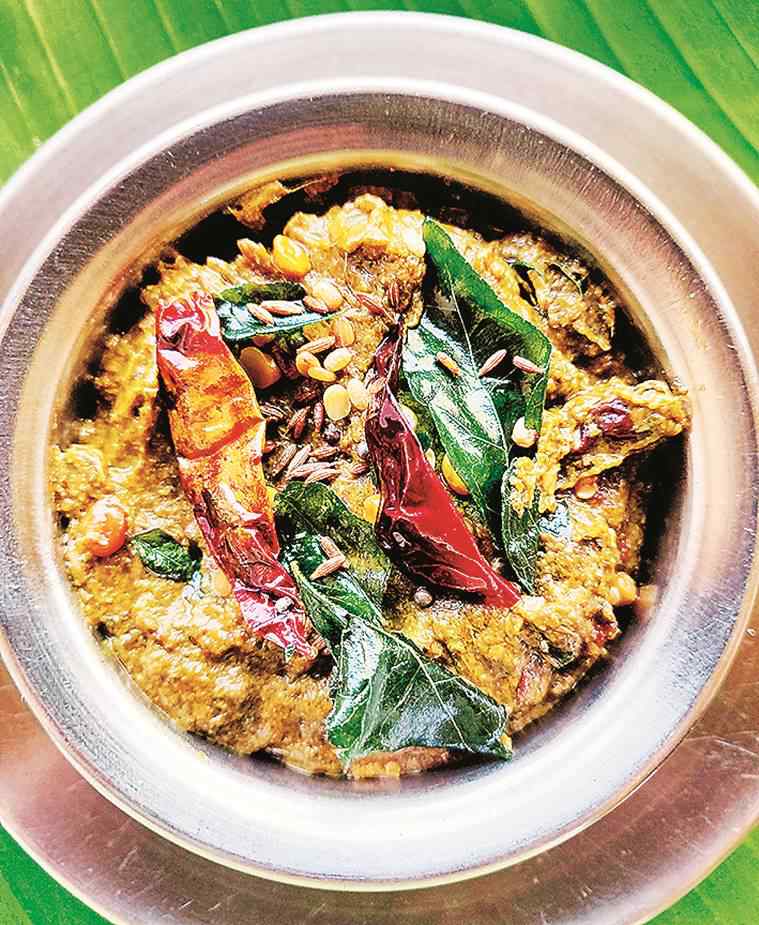 As soon as the mustard splutters, pour this tempering over the chutney and serve.
As soon as the mustard splutters, pour this tempering over the chutney and serve.
Ingredients:
250g – Dondakaya (Ivy gourd/ kundru/tendli)
2 tsp – Urad dal (whole)
2 tsp – Chana dal
5 – Green chillies
1 whole pod – Garlic
1 tsp – Coriander seeds
1 tsp – Turmeric
Salt to taste
3 tsp – Oil
For tempering
Oil
2 to 3 – Red whole chillies
1 tsp – Urad dal
1 tsp – Chana dal
1 tsp – Mustard seeds
Method:
Cut the ivy gourd into small pieces. Heat oil in a pan and add the dals. Then add garlic, gourd and the spices and saute till cooked. Once done, cool it and grind to a paste. Finally, heat oil and add the ingredients for the tempering. As soon as the mustard splutters, pour this tempering over the chutney and serve.
Courtesy: Sharmistha Cheema and Y Narayan Reddy, Tenali — The Andhra Kitchen, Delhi
Tribal Green Chilli Chutney — Nagaland
 Vegetarians can substitute pumpkin seeds for fish.
Vegetarians can substitute pumpkin seeds for fish.
Ingredients:
2 to 3 – Fermented fish
1 – Tomato (medium)
5 to 5 cloves – Naga garlic
10 to 12 – Green chilli (whole)
Salt to taste
Chives for garnishing
Method:
Roast the green chillies and fermented fish over a flame for 2-3 minutes on both sides. Put everything, except chives, into a mortar and grind with pestle till everything is well-blended and aromatic. Garnish with chives.
Vegetarians can substitute pumpkin seeds for fish.
Courtesy: Karen Yepthomi, Dzukou Tribal Kitchen
Col Skinner’s Hot Mango Chutney — Anglo-Indian recipe from Bengal
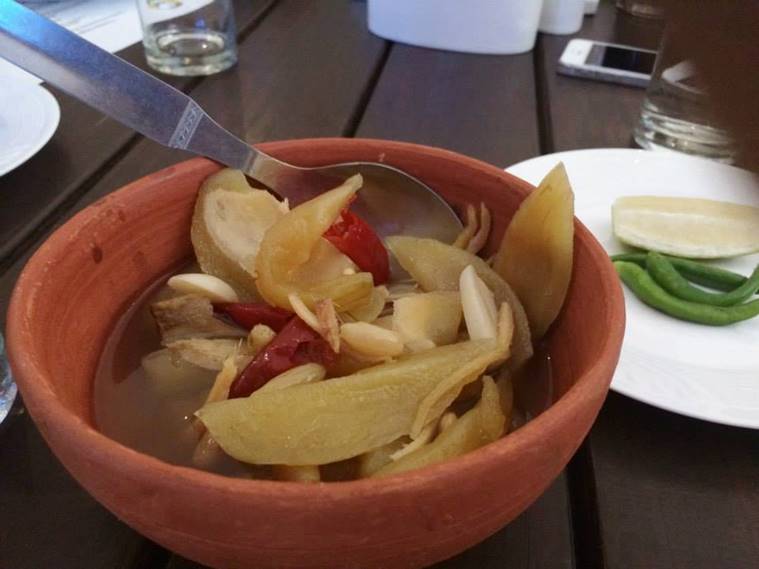 Have you tried the chutney before?
Have you tried the chutney before?
Ingredients:
250g – Green mangoes, preferably salted and dried for a few days
200g – Ginger juliennes
200g – Garlic cloves
100g – Raisins
200g – Kashmiri chillies, deseeded
25g – Whole dry chilli, deseeded
½ cup – Vinegar
200g – Sugar
Salt
Method:
Mix all of the above ingredients except for vinegar with the mangoes and cook. Do not add extra water. When mangoes, cooked along with garlic and ginger, turn into a nice thick syrup, add vinegar to taste.
Courtesy: Pritha Sen
Ambada and Coconut Chutney — Konkan coast
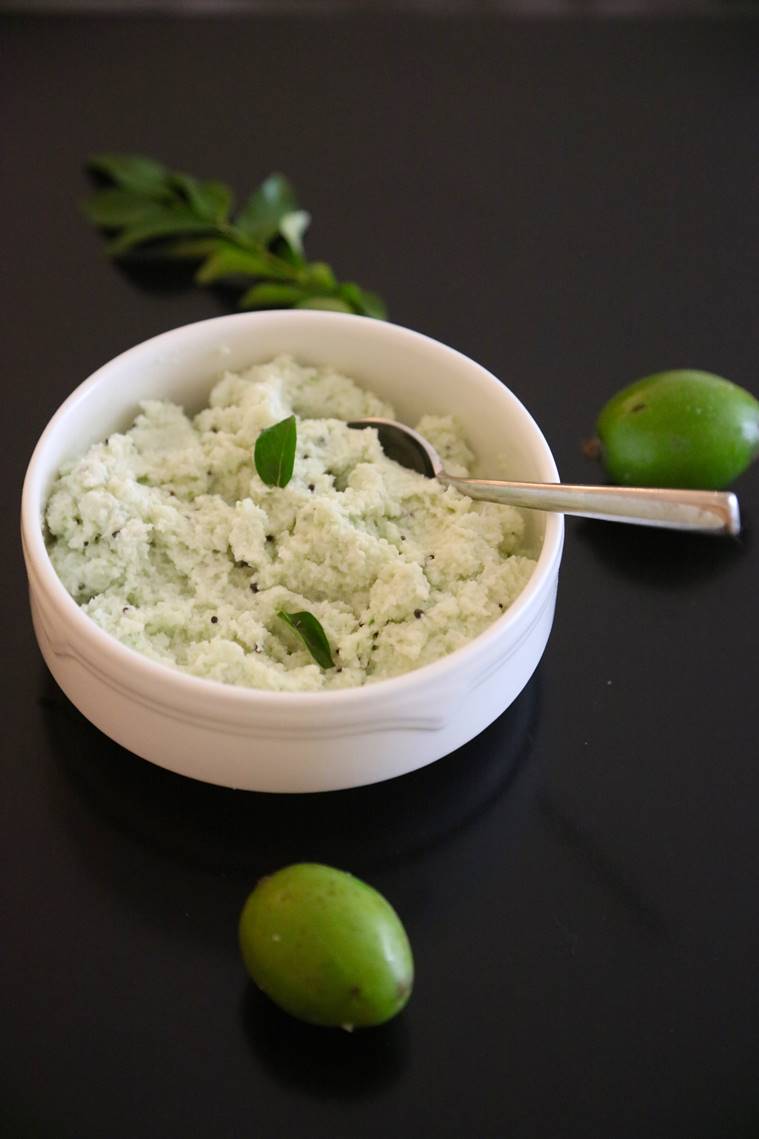 The lime sized ambada has a green skin that should be peeled to reveal a hard white fruit.
The lime sized ambada has a green skin that should be peeled to reveal a hard white fruit.
Ingredients:
1.5 cups – Fresh meat of coconut, grated
1 – Green ambada (hog plum), peeled
1 or 2 – Green chillies
For tempering
5 – Small, young curry leaves
1/2 tsp – Black mustard seeds
A pinch of asafoetida
Method:
The lime sized ambada has a green skin that should be peeled to reveal a hard white fruit. If it is very raw, the seeds inside will be relatively inseparable from the pulp. Use one half of this fruit and grate coarsely. Add more to taste.
Grind the green chilli coconut and ambada to a smooth paste. Add a little water to facilitate grinding. Add salt to taste, and more ambada if you want it more sour.
Heat oil on high flame. Add mustard seeds and cook for 30 seconds. Add curry leaves and asafoetida and remove from flame. Cool and pour over chutney. Stir well.
Courtesy Tara Deshpande
Apr 18: Latest News
- 01
- 02
- 03
- 04
- 05






































